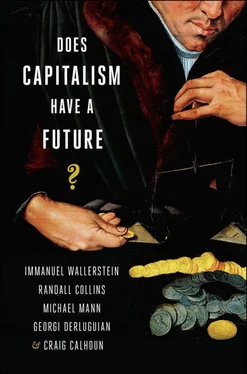Immanuel Wallerstein - Does Capitalism Have a Future?
Здесь есть возможность читать онлайн «Immanuel Wallerstein - Does Capitalism Have a Future?» весь текст электронной книги совершенно бесплатно (целиком полную версию без сокращений). В некоторых случаях можно слушать аудио, скачать через торрент в формате fb2 и присутствует краткое содержание. Город: New York, Год выпуска: 2013, ISBN: 2013, Издательство: Oxford University Press, Жанр: Публицистика, sci_economy, на английском языке. Описание произведения, (предисловие) а так же отзывы посетителей доступны на портале библиотеки ЛибКат.
- Название:Does Capitalism Have a Future?
- Автор:
- Издательство:Oxford University Press
- Жанр:
- Год:2013
- Город:New York
- ISBN:978-0-19-933084-3
- Рейтинг книги:5 / 5. Голосов: 1
-
Избранное:Добавить в избранное
- Отзывы:
-
Ваша оценка:
- 100
- 1
- 2
- 3
- 4
- 5
Does Capitalism Have a Future?: краткое содержание, описание и аннотация
Предлагаем к чтению аннотацию, описание, краткое содержание или предисловие (зависит от того, что написал сам автор книги «Does Capitalism Have a Future?»). Если вы не нашли необходимую информацию о книге — напишите в комментариях, мы постараемся отыскать её.
Does Capitalism Have a Future? — читать онлайн бесплатно полную книгу (весь текст) целиком
Ниже представлен текст книги, разбитый по страницам. Система сохранения места последней прочитанной страницы, позволяет с удобством читать онлайн бесплатно книгу «Does Capitalism Have a Future?», без необходимости каждый раз заново искать на чём Вы остановились. Поставьте закладку, и сможете в любой момент перейти на страницу, на которой закончили чтение.
Интервал:
Закладка:
ESCAPE NUMBER 5: EDUCATIONAL CREDENTIAL INFLATION, AND OTHER HIDDEN KEYNESIANISM
Credential inflation is the rise in educational requirements for jobs as a rising proportion of the population attains more advanced degrees. The value of a given educational certificate or diploma declines as more people have one, thereby motivating them to stay in school longer. In the United States, high-school (i.e., twelve-year secondary school) diplomas were comparatively rare before World War II; now high-school degrees are so commonplace that their job value is worthless. University attendance is now over 60% of the youth cohort, and is on the way to the same fate as the high-school degree. It is a worldwide trend; in South Korea, 80% of high-school graduates now go on to higher education. The main thing that inflated degrees are worth is to plough them back into the educational market, seeking still higher degrees. This in principle is an endless process; it could very well reach the situation of the Chinese mandarin class during the later dynasties [Chaffee 1985], when students continued sitting for exams into their thirties and forties—only now this would affect the vast majority of the population instead of a small elite. Different countries have gone through educational inflation at different rates, but from the second half of the 20th century onward, all of them have followed this path [Brown and Bills 2011].
Educational degrees are a currency of social respectability, traded for access to jobs; like any currency, it inflates prices (or reduces purchasing power) when autonomously driven increases in monetary supply chase a limited stock of goods, in this case chasing an ever more contested pool of upper-middle-class jobs. Educational inflation builds on itself; from the point of view of the individual degree-seeker, the best response to its declining value is to get even more education. The more persons who hold advanced degrees, the more competition among them for jobs, and the higher the educational requirements that can be demanded by employers. This leads to renewed seeking of more education, more competition, and more credential inflation.
Within this overall inflationary process, the most highly educated segment of the population has received an increasingly greater proportion of the income; at least this has been so in the United States since the 1980s. One should be wary about extrapolating this particular historical period into an eternal pattern for all times and places. Those at the top of the inflationary competition for credentials have benefited from several processes: [a] they were in the relatively safe havens when technological displacement was hitting, initially, the last of the decently paid manual labor force, and then low-paid clerical work. [b] The quality of work performance between different levels of the educational hierarchy has apparently widened. What has been insufficiently recognized is that the inflationary spiral in schooling has brought increasing alienation and perfunctory performance among students who are not at the top of the competition, those who are forced to stay in school more years but get no closer to elite jobs. Grade inflation and low standards of promotion are symptoms of this process. There is considerable evidence, from ethnographies of teenagers, of youth culture, and especially youth gangs, that the expansion of schooling has brought increasing alienation from official adult standards [Milner 2004]. The first youth gangs appeared in the early 1950s when working-class youth were first being pressured into staying in school instead of going into the labor force; and their ideology was explicitly anti-school [Schneider 1999; Cohen 1955]. This is the source of the oppositional youth culture that has grown so widely, both among the minority who belong to gangs and the majority who share their antinomian stance. Employers today complain that jobs in the lower half of the service sector are hard to fill with reliable, conscientious employees. But this is not so much a failure of mass secondary education to provide good technical skills (one hardly needs high-school math and science to greet customers politely or ship packages to the right address) as a pervasive alienation from doing menial work. The mass inflationary school system tells its students that it is providing a pathway to elite jobs, but spills most of them into an economy where menial work is all that is available unless one has outcompeted 80% of one’s school peers. No wonder they are alienated.
Although credential inflation is the primary mechanism of educational expansion, overt recognition of this process has been repressed from consciousness, in virtually a Freudian manner. In this case, the idealizing and repressing agent, the Superego of the educational world, is the prevailing technocratic ideology. Rising technical requirements of jobs drive out unskilled labor, the argument goes, and today’s high-skilled jobs demand steadily increasing levels of education. Thirty years ago, in The Credential Society [Collins 1979], I assembled evidence to show that technological change is not the driving force in rising credential requirements. The content of education is not predominantly set by technological demand; most technological skills—including the most advanced ones—are learned on the job or through informal networks, and the bureaucratic organization of education at best tries to standardize skills innovated elsewhere. In updated research on credential inflation vis-à-vis technological change [Collins 2002; Brown and Bills 2011], I have seen nothing that overturns my conclusions published in 1979. It is true that a small proportion of jobs benefit from scientific and technical education, but that is not what is driving the massive expansion of education. It is implausible that in the future most persons will be scientists or skilled technicians. Indeed, the biggest area of job growth in rich countries has been low-skilled service jobs, where it is cheaper to hire human labor than to automate [Autor and Dorn 2013]. In the current US economy, one of the biggest growth sectors is tattoo parlors [Halnon and Cohen 2006]: a non-credentialed occupation, small-scale business, low-paying and thus far immune from corporate control—and selling emblems of alienation from mainstream culture.
Although educational credential inflation expands on false premises—the ideology that more education will produce more equality of opportunity, more high-tech economic performance, and more good jobs—it does provide some degree of solution to technological displacement of the middle class. Educational credential inflation helps absorb surplus labor by keeping more people out of the labor force; and if students receive a financial subsidy, either directly or in the form of low-cost (and ultimately unrepaid) loans, it acts as hidden transfer payments. In places where the welfare state is ideologically unpopular, the mythology of education supports a hidden welfare state. Add the millions of teachers in elementary, secondary, and higher education, and their administrative staffs, and the hidden Keynesianism of educational inflation may be said to virtually keep the capitalist economy afloat.
As long as the educational system can be somehow financed, it operates as hidden Keynesianism: a hidden form of transfer payments and pump-priming, the equivalent of New Deal make-work setting the unemployed to painting murals in post offices or planting trees in conservation camps. Educational expansion is virtually the only legitimately accepted form of Keynesian economic policy, because it is not overtly recognized as such. It expands under the banner of high technology and meritocracy—it is the technology that requires a more educated labor force. In a roundabout sense this is true: it is the technological displacement of labor that makes school a place of refuge from the shrinking job pool, although no one wants to recognize the fact. No matter—as long as the number of those displaced is shunted into an equal number of those expanding the population of students, the system will survive.
Читать дальшеИнтервал:
Закладка:
Похожие книги на «Does Capitalism Have a Future?»
Представляем Вашему вниманию похожие книги на «Does Capitalism Have a Future?» списком для выбора. Мы отобрали схожую по названию и смыслу литературу в надежде предоставить читателям больше вариантов отыскать новые, интересные, ещё непрочитанные произведения.
Обсуждение, отзывы о книге «Does Capitalism Have a Future?» и просто собственные мнения читателей. Оставьте ваши комментарии, напишите, что Вы думаете о произведении, его смысле или главных героях. Укажите что конкретно понравилось, а что нет, и почему Вы так считаете.












